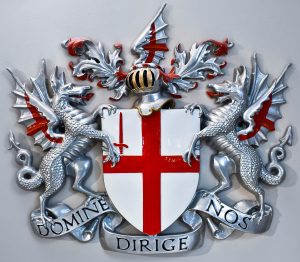
Above: The Armorial Bearings of the City of London Corporation. The shield bears the red cross of Saint George, the patron saint of England. The undersides of the dragons’ wings on either side of the shield and on top of the helmet also bear the St George’s cross, likely inspired by the legend of slaying the dragon. To the top-left of the shield is a representation of the Sword of Saint Paul, the patron saint of the City of London. The Latin motto of the Corporation – The earliest record of the Latin slogan dates from 1633.
The City of London Corporation is the local governing body for the Square Mile: the commercial and financial heart of the United Kingdom.
The Corporation is the oldest local authority in the country and pre-dates Parliament. The City of London has enjoyed certain freedoms and had a form of civic administration since before the Norman Conquest in 1066. Originally a Roman trading post called Londinium, the City won the right to run its own affairs as its status grew through increasing financial importance as a centre for trade and concessions were gained from the Crown.
In the present day the concern of the Corporation is to serve the interests of the City of London’s citizens through local government, to maintain and enhance the status of the City as the world’s leading international financial centre, and through this to serve the national interest in supporting the UK economy.
The Corporation provides and administers a host of additional facilities to benefit the nation including the Old Bailey, the Barbican Arts Centre, and open spaces including Epping Forest, Hampstead Heath, and Highgate Wood.
Contents:
1. Introduction to the Old Bailey
2. The Old Bailey – A Short History
3. Some Famous Old Bailey Trials
4. The Present Building
5. The Organisation of the Old Bailey
6. The Old Bailey in the Popular Imagination
7. Bibliography and Further Readings
8. Index of Images
9. Thanks
- Introduction to the Old Bailey
The glittering figure of Justice that stands commandingly above the streets of the City of London is an instantly recognisable symbol that immediately conveys the purpose, majesty and drama of the building she proudly crowns—the Central Criminal Court known to all as the Old Bailey, the most famous criminal court in the world.
The Old Bailey has been London’s principal criminal court for centuries. Now a crown court centre, it hears cases from the City of London and the Greater London area, those remitted to it from England and Wales and those arising on board British ships at sea. Over the years it has been the setting for celebrated trials, often involving the most serious crimes, and has been graced by many outstanding advocates —masters of eloquence and subtle legal argument—and distinguished judges. The famous court no. 1, redolent of the rich history of the Old Bailey , is in the Edwardian part of the present building— which is renowned for its splendid architecture and magnificent marbled and painted halls.
The courthouse is built on the site of the notorious Newgate Prison, the principal gaol in London since the Middle Ages and ‘a dreadful place of incarceration,’ outside of which, for 85 years, prisoners sentenced to death were publicly hanged. The court was originally housed in buildings alongside the prison, its purpose being to try those who were imprisoned there.
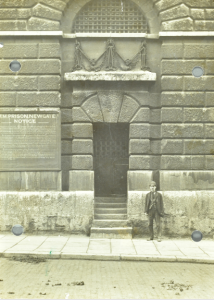
- The Old Bailey – A Short History
The history of the court dates from before the time when the first Old Bailey courthouse was built in the sixteenth century. The earlier sessions were held in nearby rooms specially hired for the purpose or in Newgate Prison itself, originally the gatehouse of Newgate in the City wall. The medieval Newgate had replaced the original Roman west gate into the City, and all the courthouses were built on the line of the Roman City wall, a section of which is preserved in the basement of the present building.
The gate was recorded in the Domesday Book of 1086, compiled after the Norman Conquest, as being kept by ‘William the Chamberlain.’ Prisoners were held in the gatehouse itself from an early date. In the late-twelfth century, following Henry II’s legal enactments that required the construction of gaols in every locality where the king’s judges, dispatched from Westminster, would administer the process of ‘gaol delivery,’ a large prison was constructed alongside the wall next to the gate. It was to become London’s most notorious prison:
‘An abode of misery and despair, a hell such as Dante might have conceived’, Memoires
The Venetian adventurer and explorer Casanova’s description of Newgate Prison, prompted from an unfortunate but thankfully brief period he spent there, was an opinion likely shared by all who were unfortunate enough to be incarcerated there during its long history.
Newgate was a prison for those accused of serious crimes from both the City of London and the County of Middlesex. Though a royal prison, the gaol was administered by the City Sheriffs (an important position which dates from pre-Conquest England and survives in today’s City of London Corporation) and run by the Keeper and his gaolers. The prisoners were tried at regular intervals by royal justices acting as ‘commissioners of gaol delivery’ for Newgate, but some communities took issue with what they saw as an intrusion of royal judges into local justice. Because of uproar from the citizens of London, it is likely that Edward III, King from 1327-1377, agreed that the Lord Mayor of London would be included as one of the justices for gaol delivery at Newgate.

In the early history of Newgate Prison there was only one gaol delivery a year and prisoners suffered from a lack of air, overcrowding, and epidemics of ‘gaol fever,’ now known to us as typhus. Newgate was regarded as a ‘heynouse’ or hateful gaol, and in 1381 was targeted in the Peasants Revolt when it was broken open and the prisoners freed.
In 1414, the Keeper of Newgate and 64 others died during an outbreak of gaol fever. Despite the persistence of these conditions, the squalor of the prison did not go un-challenged in the Middle Ages. London’s most famous Lord Mayor, Richard ‘Dick’ Whittington, vehemently attacked the state of the gaol in 1419:
‘By reason of the foetid and corrupt atmosphere that is in the heinous gaol of Newgate many persons are dead who would be alive…’
When Whittington died in 1423, he left instructions for the proceeds of his estate to be devoted to works of charity. The executors of his will, no doubt knowing how he felt about the prison, obtained the King’s license to pull down the old building for a new, larger gaol which was built, still in the form of a gatehouse, across the street.
Despite these improvements, and the fact that more gaol deliveries of prisoners and other sessions were held, overcrowding and gaol fever persisted, and the treatment of the prisoners by the Keeper, or his gaolers, was considered scandalous. As the wealth that could be gained in the position was considerable, the Keeper brought his office. Prisoners were regarded as a source of income, and extorted money for such privileges as better food and accommodation or having their heavy irons left off. The Keeper also made money from the sale of fluid sustenance . When Thomas Knowles, twice Lord Mayor, laid fresh water to the prison at about the time of the new building, the Keeper charged prisoners a fee for the water charitably provided.
Gaol fever was so prevalent that judges trying prisoners in the gaol were at risk, and in 1539 a separate courthouse – the first Old Bailey – was built. The City’s Common Council resolved:
‘Forasmoche as comonly prisons where theeffes and other malefactors be deteigned for there offences be many tymes vysyted with Syknes and by reason thereof the place ys infectyd and moche peryll and daungyer hath chauncyd to the Justyces…for delyveraunce of the Kynges gaole. And forasmoche as there ys no conveyent place wtyn this Cytye for that purpose where the sayd delyverie shalbe made…It ys nowe agreed for the comfort of all thys Cytye that a convenyent place be made for that purpose holsomly to be ordered and prepared upon the common grownde of thys Cytye yn the olde bayly of London…’
The Sessions House was built on the south side of the gaol in the Old Bailey or ballium – the fortified enclosure adjoining the outside of the City wall – and between sessions it was hired to freemen of the City. The end of the sixteenth century witnessed perhaps the most distinguished judge to have served at the Old Bailey: Sir Edward Coke, who was the Recorder of London in 1591-2. Coke left the post on being selected as Solicitor-General and became Speaker of the House of Commons the following year and Attorney General a year later. Subsequently he became Chief Justice of the Common Pleas and then of the King’s Bench. He was largely responsible for the Petition of Right of 1628, and his law reports helped to systemise and consolidate the common law of England.
In the Great Fire of 1666, in which the City of London was devastated with the loss of some houses, both the gaol and courthouse were badly damaged. The courthouse was rebuilt in 1672 by Sir Christopher Wren who was also responsible for much of the rebuilding in the City after the fire including the magnificent St Paul’s Cathedral nearby.
The later seventeenth century was also marked by the tenure of perhaps the most infamous judge to have sat at the Old Bailey: Judge Jeffreys, who became Common Serjeant in 1671 at the age of 23 and Recorder of London in 1678, resigning two years later. He earned his infamous reputation by his cruel conduct of the ‘Bloody Assize’ which followed Monmouth’s Rebellion in 1685, but before that at the Old Bailey he gained a name for his severe sentences in the ‘Popish Plot’ cases. He resigned as Recorder after the City petitioned Parliament for his removal from office. He later became Chief Justice of the King’s Bench and then Lord Chancellor.
In 1726 the prison was finally enlarged when two adjacent houses were converted into condemned cells. By this time the Sessions House, where sessions were now held nine or ten times a year, had become a ‘fair and stately building’ with spectators’ galleries to which the Keeper charged a fee for admission. To reduce the risk of prisoners infecting others with gaol fever, one end of the court was open to the weather, but this caused so much discomfort it was later enclosed
The treatment of prisoners, who were brought into court in irons, was brutal, with those refusing to plead suffering the torture of ‘pressing’ by having weights placed on their spread-eagled bodies. Many held out until they died, bravely enduring the pain to avoid confiscation of their goods from their families on conviction. This practice had ended by about the mid eighteenth century, but left a reminder in the name Press Yard, which was next to the part of the prison where wealthy prisoners could buy more comfortable, better ventilated accommodation, paying the Keeper for relief from intolerable conditions elsewhere.
Despite the apparent hopelessness of conditions for those held in Newgate, some made a name for themselves through their daring escapes. The most famous of these was the notorious thief of early-eighteenth-century London, Jack Sheppard. Having already been arrested, imprisoned, and having escaped twice in the early months of 1724, Sheppard was again arrested and sentenced to death at the Old Bailey on August 12th and held at Newgate.
On the 31st August—four days before his execution date—Sheppard escaped. He had loosened the iron bars on the window of his cell, and whilst his visitors distracted the prison guards he managed to squeeze himself through the metal grille and was smuggled out of the prison in women’s’ clothes. Moving down through the City to Blackfriars, Sheppard took a boat along the Thames to Westminster and made his getaway.
Sheppard was recaptured on September 10th by a party sent out from Newgate and returned to the condemned cell and placed in handcuffs and leg irons. However, on the night of the 15th October he took advantage of a disturbance which had spread from the Sessions House to the prison and made his final, and most daring, escape. He removed his handcuffs and, with leg irons still attached, escaped through a chimney to an upper room of the prison and on to the roof of Newgate. He returned to his cell to retrieve a blanket which he used to move from the roof to that of a nearby house and down to the street to remove his leg irons. Sheppard’s final taste of freedom was to be short-lived. Captured again after a final theft, he was sent to the most secure cell at Newgate where he could be constantly monitored. Sheppard’s fame was enormous by this point, and it was said the Keepers earned more than £200 charging visitors to see him. On November 16th Sheppard was taken to the gallows at Tyburn (close to the current location of Marble Arch) and hanged before a crowd of 200,000 people galvanised by the stories of his repeated escapes.
Prisoner escapes were not the only serious concern for those working at the Old Bailey and Newgate in the eighteenth century. The worst fears about the spread of gaol fever were realised in 1750 when a virulent epidemic sweeping the prison was brought into the Sessions House, and the Lord Mayor, two judges, an Alderman and some 50 others attending the April sessions died as a result. Attempts were made to improve ventilation in the prison by the installation of a windmill-like machine designed by Dr Stephen Hales on the roof connected by tubes to the rooms and wards below to draw off the foul air, but prisoners continued to die of the fever.
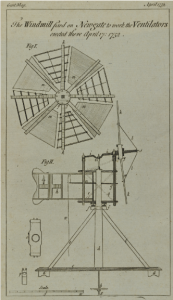
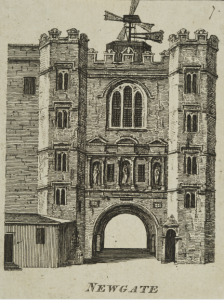
As a further precaution against infection, and to mask the stench of the prisoners, the custom began of strewing strong-smelling herbs in court and of the judges carrying posies.
It soon became apparent that the only solution to the problems caused by the conditions at Newgate was to rebuild and enlarge the prison, and after years of negotiation, an Act of Parliament in 1767 authorised the City to do this. The estimated cost of £50,000 was to be defrayed out of a tax on coal coming into the Port of London, but in the end the construction costs far exceeded this sum.
In 1768 George Dance the Younger succeeded his father – who had constructed the Lord Mayor’s official residence, Mansion House – as Architect and Surveyor to the Corporation of London. Dance’s Newgate prison was among his first major public works and became his most celebrated design. The new prison was an example of L’Architecture terrible,a style advocated by the French architect Jacques-François Blondel who theorised that a heaviness and deliberate inelegance to prisons would emphasise their purpose and serve as a deterrent to crime. Newgate was constructed with massive blank reinforced walls and extremely small windows, as well as carved chains over the entrance to instil fear in onlookers.
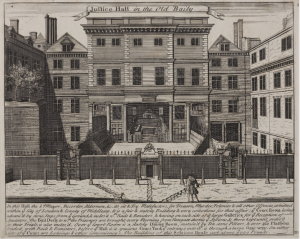
The first stone was laid in 1770 by the Lord Mayor, William Beckford. Meanwhile Dance’s plans to build a new courthouse were accepted by the City. This was finished in 1774, at the southern end of which the new prison was taking shape, as before separated from it by a yard. When enough of the prison was complete for prisoners to be transferred there, the old Newgate which straddled the road was demolished, although some remains were still standing on the north side in 1781.
The new prison was almost completed when, in 1780, frenzied rioters roused by the anti-Catholic Lord George Gordon surged through the City, releasing prisoners from the gaol and setting fire to the buildings, destroying the inside of Newgate and looting and damaging the Sessions House. The courthouse was repaired and the huge task of rebuilding the prison undertaken, with financial help from Parliament. It was completed in 1785 and the accommodation now separated the three main classes of prisoners – debtors, male felons and female felons – and included an infirmary for the treatment of sick prisoners.

Whilst improvements began to be made to the physical conditions of Newgate, the final decades of the eighteenth century also saw notable developments in the administration of justice itself at the adjoining Old Bailey. Advocates had first been allowed to act in criminal cases in the 1730s, but it was rare before the 1780s for complainants or defendants to seek their services. Another notable difference from today’s justice system was the fact that the accused were required to present their own defence were barred from giving evidence themselves and heard the evidence against them for the very first time as they stood in the court! The reason for this, as a prominent legal theorist of the time noted, was that:
‘…”the very Speech, Gesture and Countenance, and Manner of Defence of those who are Guilty, when they speak for themselves, may often help to disclose the Truth.”
- William Hawkins, A Treatise on the Pleas of the Crown (1716-21)

Needless to say, defendants found themselves at a considerable disadvantage and defence counsel – when employed – could not address the jury directly, which made their cross-examination of witnesses crucial to highlighting flaws in prosecution cases. Barrister William Garrow (1760-1840) made a name for himself towards the end of the eighteenth century by his skilful defence advocacy at the Old Bailey. Over time his interventions and those of other defence counsel on behalf of their clients encouraged the development of the law of evidence and a clearer sense of the rights of Defendants, including the right to be presumed innocent until proven guilty . Garrow and his peers both at the Old Bailey and other courts contributed in no small way to the development of the modern adversarial court system in use today, a system which is so ingrained in the modern justice system that we take it for granted.
Punishment, however, remained a brutal and public affair during these years. The English legal system of the time is aptly referred to as the ‘Bloody Code’ due to the huge number of crimes that could receive a death sentence: 225 by the end of the eighteenth century. (Note however that being sent to jail was a likely death sentence in itself, with nearly a quarter of all prisoners dying from prison-acquired infections.)
The last execution at Tyburn, London’s traditional site for public executions, took place in 1783. This ended 600 years of the carnival-like processions in which condemned prisoners were taken to the gallows there by cart amid huge crowds of onlookers. One of the rituals of this procession permitted the prisoner to stop at a public house for a final drink, the less-terrified prisoners quipping to the patron that they would buy them one in return on their way back!
The street beside Newgate prison, from which it takes its colloquial name, now became the scene of hangings of those sentenced to death in the courthouse. Hangings remained a public spectacle and people flocked to watch them; window space in buildings overlooking the gallows outside the prison were rented to the wealthy, and the Magpie and Stump pub (still at the same location today) was considered a prime viewing spot. Other people crowded into the street. The popularity of executions was such that on one occasion in 1807, 28 people were killed in a crush attending an execution at Newgate.
The last burning of a hanged woman – Christian Murphy – who had been sentenced to death for coining offences – was outside the prison in 1789. The last ‘beheading’ in the country was outside the prison in 1820 when the Cato Street conspirators, five men who had conspired to assassinate the Cabinet, were hanged and then decapitated as traitors.
Following the population increase in the last half of the eighteenth century the new gaol soon became overcrowded. It was at Newgate that Quaker Elizabeth Fry began her reforming work, first visiting the prison in 1813 when she was moved by the plight of the women prisoners, many of them drunk, crowded into two wards with their children and sleeping on the floor without bedding. In 1817 she formed a school for the children – most of whom had been born in the prison – with a young prisoner as teacher and set up the Association for the Improvement of Female Prisoners in Newgate. A matron was appointed and the women were given work making clothes to sell,. In 1821, the Association expanded and became the British Ladies’ Society for Promoting the Reformation of Female Prisoners. Elizabeth Fry’s influence spread throughout Europe, and her pioneering work and that of other early nineteenth-century reformers stimulated the government into passing legislation which sought to improve conditions inside prisons.
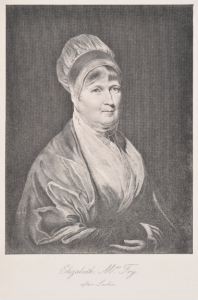
The Sessions House, which became too small for the increasing number of cases, was enlarged in 1824 when a second courtroom was added by converting a building on its south side. A tribute to the work of the enlarged court came ten years later when an Act of Parliament made it the Central Criminal Court, extending its jurisdiction beyond the City and Middlesex to parts of Essex, Surrey and Kent and to British ships on the high seas. But although sessions were held at least twelve times a year, the extra workload meant the building was again too small, and in 1840 another room was added for the Grand Jury, prosecutors and witnesses, and a third court was provided eight years later.
The lucrative practice of charging for admission to galleries ended in 1860, while punishments were gradually becoming more humane. In 1837 the pillory which stood outside the prison was removed, and in the 1850s sentences of transportation—whereby prisoners were exiled to British colonies in America and Australia— ended. This practice was believed to be able to reform offenders but was also considered an effective deterrent to crime and an advantage to the wider public by removing ‘hardened criminals’ from society. Not all sentenced to this fate could be described as the latter, however. One example among many would be Mary Tyler, aged 13, who was sentenced at the Old Bailey for the theft of a horse and cart and later transported overseas in 1809.
By 1861 the number of offences punishable by death had been severely limited and in 1868 the last public hanging in Britain took place outside Newgate. Michael Barrett was executed for his part in a Fenian plot to blow up Clerkenwell Detention House, in which an explosion killed a number of people. Later executions took place inside the prison.
But the problems of the buildings remained. The condition of the gaol had by the 1850s become so bad and the Sessions House so inadequate that a City committee recommended demolishing and rebuilding both, making the gaol smaller because the recently opened Holloway Prison could take many of the prisoners. But it was not until the end of the century that anything so extensive could be done. Meanwhile, the City spent many thousands of pounds on repairs and alterations to the prison and courthouse. Horace Jones, the City Architect, prepared plans for a new Sessions House in 1878, but the designs were rejected the following year by the General Purposes Committee of the Court of Aldermen on the grounds that the site was inadequate and the access and approaches poor.
In 1878 all prisons came under government control and by 1881 Newgate was used only for the temporary detention of prisoners awaiting trial or execution. By this time frustrations with the state of the courthouse had come to a head. In 1894 the formidable barrister Edward Marshall Hall used the closing remarks of his defence in the Grafton Street murder case to rail against the squalor of the building:
‘This court is utterly unfitted for the administration of justice […] and is a disgrace to the richest municipality in the world’
After many years of negotiation, the City finally acquired the prison and in 1898 was able to go ahead with plans for a new Central Criminal Court on the site of the prison and courthouse.
The design of the large new courthouse to replace the architecturally acclaimed prison on an important site close to St Paul’s Cathedral was chosen by competition. In 1898 the Royal Institute of British Architects nominated six architects to submit plans, putting no restriction on style but requiring impressiveness and dignity without excessive ornamentation. Each design was given a number, the identity of the competing architects being kept secret. After six months, the design of Edward Mountford, who chose to complement the nearby dome of St Paul’s, which then dominated the City skyline, was selected.
The first stone of the new Old Bailey was laid in 1902, and five years later the building, with four courtrooms, 90 cells for temporary reception of prisoners awaiting trial, and stones from the demolished prison used in its façade, was completed. The new courthouse cost the City Corporation nearly £400,000 and was opened in 1907 by King Edward VII.
Seven years later, on 10 May 1941, in a very heavy Second World War air raid, during which the Palace of Westminster sustained a direct hit, a bomb fell on the north-west corner of the Old Bailey, demolishing court No. 2 and causing extensive damage elsewhere. Two members of staff on fire-watch duty were killed in the raid. Restoration work over some six years included replacing marble facings inside the building with marble imported from the original quarries in Italy, Sicily and Belgium. Professor Gerald Moira, one of the two artists who had painted the lunettes in the Grand Hall nearly 50 years earlier , returned to direct the repainting of those that had been damaged or destroyed. A commemorative plaque in the Grand Hall records this.
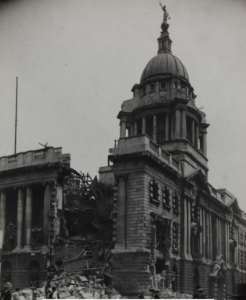
During the restoration work, a fifth courtroom was added, opening in 1952, but, because of the rapidly increasing work following the large growth in crime after the war, further courts were soon needed. Over the next seven years two more courtrooms were opened, then three temporary courts were created in the building, and in 1967-8 a warehouse and offices opposite the courthouse were converted to provide three more courtrooms. But the total of thirteen courtrooms was still not enough to deal with the increasing number of cases.
In 1966 plans for a twelve-courtroom extension were approved. The first phase, completed in 1969, was the construction of administrative offices in Warwick Square next to the late-Victorian Cutlers’ Hall. The second phase was of courts fronting the Old Bailey. The £7 million extension, financed entirely by City funds, was opened by the Lord Chancellor, Lord Hailsham, in 1972.
In the same year, the Courts Act 1971 came into effect, integrating the Central Criminal Court into the national system of crown court centres. It became one of the London centres but retained its Central Criminal Court title and powers. Formerly, staff administering the court were appointed and paid by the City of London Corporation; following the Act that function was transferred to the Lord Chancellor’s Department, which became responsible for the administration of the court’s business, the City Corporation remaining responsible for the administration of the building.
An IRA car bomb outside the Old Bailey in 1973 caused little serious damage to the building, but nearly 150 people were injured by flying glass. All the windows were blown out in the explosion and a piece of glass remains embedded in an inside wall of the ground-floor concourse as a permanent reminder of the event.
In the 1970s the work of the courts continued to increase. The list of cases awaiting trial became so long that the temporary courts constructed before the extension remained in use for several years.
The list, which includes cases being prepared for hearing, has now been considerably reduced. One reason for this is that minor cases are often transferred to other crown court centres within the Greater London area, with the Old Bailey hearing major cases. The eighteen courtrooms are now in constant use. Court no. 19 is used as a press-overflow area.
- Some Famous Old Bailey Trials
In 1670 a case was heard at the Old Bailey which is remembered in a commemorative plaque in the courthouse of today: that of Quakers William Penn and William Mead. It is a legal landmark because of the jury’s refusal to convict them, which led to the establishment of the right of juries to give a verdict according to conscience.
Penn – later famous as the founder of Pennsylvania – and Mead were tried for preaching to a ‘tumultuous assembly’ in Gracechurch Street. This was after a group of Quakers had been ejected from their meeting house under a law which banned non-Anglican religious meetings. The jury was warned by the judge to observe the evidence of the witnesses at their peril and when, after a retirement, four of them failed to agree with the others they were berated by the Bench. The jury later found Mead not guilty and Penn guilty only of “speaking or preaching to an assembly”.
The jury were locked up for the night without food or warmth but the next morning found them resolute, and, despite bullying, they refused to change their minds and were locked up for a second night. On the third day they found both Penn and Mead not guilty. The judges accepted their verdict only after making each juror verify it, and then fined the jurors for following their own “judgements and opinions” rather than the advice given and ordered them to be imprisoned until the fines were paid.
Four of the jurors spent months in Newgate gaol, refusing to pay until their case, brought by one of them, Edward Bushell, could be put before a higher court. The judgment of that court, given by the Chief Justice, Sir John Vaughn, set aside the fines and set a precedent by prohibiting the fining of jurors in the future, establishing the vital principle that juries should deliver their verdicts according to their conscience, the cornerstone of the jury system throughout the common law world. The case is now known in the history of the law as ‘Bushell’s case’.
In 1703, Daniel Defoe, in publishing his pamphlet The Shortest Way with the Dissenters, an ironical satire on the intolerance of the High Church party was charged at the Old Bailey with ‘seditious libel’.Spectators paid a shilling a seat to see the proceedings. He was sentenced to stand in the pillory three times, fined and had to remain in Newgate gaol until he could produce sureties for his good behaviour for seven years. While in the gaol – where he paid for the better accommodation by the Press Yard – he continued to write, composing his Hymn to the Pillory, which was handed out as he stood in the pillory at Cornhill, by the Royal Exchange. The Hymn helped turn the humiliating experience into something of a triumph for Defoe, with the Pillory garlanded and the mob drinking to his health.
Defoe later drew on his prison experience for his novel Moll Flanders and wrote the lives of some of the most famous criminals of the time, such as Jonathan Wild, who was tried and sentenced to death at the Old Bailey. Wild was a notorious villain, both thief-taker and organiser of a gang of thieves, making huge profits selling stolen goods back to their owners. His exploits provided material for literary works which included Fielding’s satire Jonathan Wild the Great, published eighteen years after Wild was hanged at Tyburn in 1725.
In 1895 the trials of Oscar Wilde, the famous Victorian writer known in particular for The Importance of Being Earnest and The Picture of Dorian Gray, were held at the Old Bailey amid huge public interest. The Marquess of Queensbury, enraged at the relationship between Wilde and his son Lord Alfred Douglas, had left a calling card at Wilde’s club labelling him a sodomite. Wilde took out a warrant against Queensbury for criminal libel and the latter entered a plea of justification.
The libel trial was held from the 3rd—5th April 1895. Pressed on questions of ‘immorality’ in his literary works and his associations with other men, the trial ended with Wilde’s attempt to withdraw the prosecution case.
A warrant for Wilde’s arrest was now applied for under the Criminal Law Amendment Act (1885) which had strengthened legislation against homosexuality. Wilde was tried with having sexual relations with a number of male partners. The first trial was held from the 26th April— 1st May and ended with the jury in disagreement after four hours. The second trial took place from the 22nd–25th of May with Wilde found guilty and sentenced to two years penal servitude with hard labour.
Temporarily held at Newgate and then transferred to Pentonville and Wandsworth Prisons where he spent hours walking the treadmill and picking oakum, Wilde served the majority of his sentence at Reading gaol. From those experiences he wrote The Ballad of Reading Gaol which served to highlight the brutalisation and punishment shared by prisoners. Wilde’s conviction, and those of all men convicted in Britain by historical legislation that outlawed homosexual acts, was overturned in 2017 with the passing of the Alan Turing Law.
Among the most famous of the early trials that were held in Mountford’s Old Bailey was that of Dr Hawley Crippen, tried and sentenced to death for the murder of his wife Cora. Following Cora’s disappearance after a party held at the Crippens’ home on January 31st, 1910, Hawley claimed that Cora had returned home to the United States and later added that she had died in California. Her friends, however, suspected foul play as Hawley moved his lover—Ethel le Neve—into the house. The house was searched, and Hawley questioned on the 8th July—now changing his tale and saying that Cora had left him, and out of humiliation he had made up the story of her departure to America and subsequent death.
Hawley was panicked by the questioning and fled overseas with Ethel. Their disappearance alerted Scotland Yard and the police again searched the house, making the grim discovery of remains, believed to be Cora’s, beneath the floor of the coal cellar. The remains were later tested and found to contain traces of poison. Hawley and Ethel were sailing to Canada by this time; however, the ship’s captain recognised the pair—who were travelling under pseudonyms—and alerted the British authorities via wireless. Detective Inspector Walter Dew was despatched aboard a faster liner to arrive before Hawley and Ethel, who were arrested upon their arrival in Montreal.
Hawley was tried from the 18th—22nd October in a controversial case which fascinated, and continues to fascinate, the public. The evidence of the prosecution was grisly; scar tissue said to match Cora’s was shown in the courtroom to prove the body to be hers and not, as Hawley protested, one that must have been there before he bought the house. Ethel was acquitted as an accessory after the fact in a separate trial, but Hawley was convicted and hanged on 23rd November 1910.
In March 1969 the notorious Kray twins, east-end gangsters Ronnie and Reggie, were sentenced along with six others in the famous court no.1 of the Old Bailey for murder. The twins, with their older brother Charles and associates from the criminal underworld, had established a clubbing and gambling empire that stretched across the capital. For a time they held celebrity status in fashionable 1960s London, with the stars of the time frequenting their clubs. During the trial itself Ronnie infamously quipped ‘If wasn’t here, I could be having tea with Judy Garland.’
The Krays had many influential friends and maintained their position and illegal activities through intimidation, extortion, and bribery. However, after the murders, by Ronnie of rival gang member George Cornell in 1966, and by Reggie of Jack ‘the Hat’ McVitie (a member of the Kray firm) in 1967, they were arrested and brought to trial.
With the Krays detained, witnesses were forthcoming and cooperative. Furthermore, additional precautions were taken to ensure the delivery of justice by the Court. Sixty plainclothes police officers kept a 24-hour watch on the jurors throughout the trial, following them home from court and even into public houses to ensure they would not be intimidated or bribed to sway the verdict in favour of the accused.
The jury took 7 hours to deliver their verdict: Ronnie and Reggie were convicted of the murders and each received 30 years , which at the time were the longest sentences passed at the Old Bailey. On passing sentence Judge Justice Melford Stevenson remarked ‘In my view, society has earned a rest from your activities’ and praised the work of the jury.
- The Present Building
The Edwardian baroque of Mountford’s courthouse and the modern simplicity of McMorran and Whitby’s extension combine to create a façade of strength and dignity. Mountford’s building has a base of Cornish granite with Portland stone facing above, and the extension is also faced largely with Portland stone.
The Statue of Justice crowning the court stands 60 metres above the street and is 3.7 metres high, cast in bronze weighing 22 tonnes and is covered with gold leaf. Her outstretched arms span 2.4 metre; in her right hand she holds the sword of retribution and in her left the equally balanced scales of justice. She stands upon a globe, for justice straddles the world. Especially distinguished from other statues of Justice by not being blindfolded., she was sculpted by Frederick William Pomeroy, who was also responsible for the statues over the Old Bailey’s main entrance depicting the Recording Angel with Fortitude and Truth on either side. Above them Pomeroy carved the inscription ‘Defend the children of the poor and punish the wrongdoer’, a verse from Psalm 72. The main entrance is now used only twice a year when the Lord Mayor visits the court in state as a Chief Justice of the City.
Inside, Mountford’s main halls – the lower hall and Grand Hall linked by the great stairway – are lined with rich marble from Italy, Sicily, Greece, Belgium and Sweden. The arches are of white Ancaster stone and the ceilings of the alcoves in the lower hall contain blue mosaics. The lunettes in Grand Hall were painted by Professor Gerald Moira and his assistants, and Pomeroy sculpted the figures in relief representing Justice, Mercy, Charity and Temperance which are in the pendentives to the main dome.
Six of the seven lunettes, symbolic representations of justice, are below the two smaller domes. Below the south dome, figures representing all aspects of national life pay homage to the figure of justice on the steps of St Paul’s Cathedral, Moses on the mountain with the tablets of stone represents the reception of Mosaic law into English law, and King Alfred at Winchester with his scrolls represents the reception of Anglo Saxon law into English law. The lunettes below the north dome show the Emperor Constantine and the reception of Roman law into English law, the celebration of the Magna Carta, and the Golden Age before the rule of law was necessary to regulate mankind. In the latter is a self-portrait of Moira with his palette; he is said to appear in all the lunettes. The north dome lunettes are post-war replacements by Moira and his assistants of the 1907 paintings destroyed by bombing; the destroyed paintings – of the Golden Age, Roman law and Greek law – were those of Sir William Richmond, who was consulted as to the original decoration of the first-floor hall and gave his advice on the whole scheme.
The smaller domes are 14.3 metres high and contain coats of arms of the royal houses from Saxon to Windsor times. Below them are eight portraits of people connected with the Old Bailey – architects George Dance the Younger and Edward Mountford, prison reformers John Howard and Elizabeth Fry, Lord Mayors Richard Whittington and William Beckford, and Recorders of London Sir Heneage Finch, who became Speaker of the House of Commons in the seventeenth century, and Sir James Eyre, who became Chief Justice of the Common Pleas in the eighteenth century.
The panels of the 20.4-metre-high main dome contain paintings symbolising Labour, Art, Learning and Truth, with the swords and mace of the City of London in between. A new lunette below the main dome is Moira’s tribute to the emergency services in the Second World War and shows the damaged Old Bailey in the background. Moira also designed the two windows on the stairway, the circular window at the top showing the arms of the Recorders of London. The allegorical painting on the left of the window depicts Time protecting Truth from Falsehood, and that on the right shows Justice, Righteousness and Crime. The window below contains the royal arms of King Edward VII, the City and adjoining counties within the jurisdiction of the court. The four original courts, Numbers 1 to 4, which are all oak panelled, lead off Grand Hall.
The statue in the hall of Elizabeth Fry was sculpted by Alfred Drury in 1913, and those of Charles I, Charles II and Sir Thomas Gresham are by John Bushnell, from the second Royal Exchange of 1671. In the ground floor concourse are Victorian statues of monarchs – James I, Charles I, Charles II, William III, Mary II, George IV and William IV
The Grand Hall and the lower hall link with the 1972 extension, which maintains their proportions and sense of space. The eighteen courts – six in the 1907 building and twelve in the extension – are on three floors, and the building also has administration offices, judges’ rooms, accommodation for barristers, jurors, witnesses and the press, four restaurants, and modern cell accommodation for up to 74 defendants on remand and on trial in the courts above. The building is also home to the two Sheriffs of London, who spend their elected year living and working at the Old Bailey.
There are several reminders of the darker history of the Old Bailey site in and around the current building. The ‘Newgate knocker’ – an iron door knocker from Newgate gaol – is held securely in the Court’s collections. The old saying ‘as black as Newgate’s knocker’ – which means that something is very dark in colour or character – refers to this artefact, drawing upon the general notoriety of the prison. Another reminder of Newgate survives in Amen Court to the rear of the Old Bailey where a section of the old prison wall remains to this day. In nearby St Sepulchre’s church, opposite the Old Bailey on Holborn Viaduct, the Newgate execution bell is displayed. It was bought for the church in the early-seventeenth century on the condition that it be rung in the condemned cells of Newgate prisoners by the church clerk on the eve of their execution so that they might repent and save their souls. The clerk offered them the following advice as he rang the bell:
“All you that in the condemned hole do lie,
Prepare you, for tomorrow you shall die.
Watch all, and pray, the hour is drawing near,
That you before Almighty God will appear.
Examine well yourselves, in time repent,
That you not to eternal flames be sent,
And when St Sepulcher’s bell tomorrow tolls,
The Lord above have mercy on your souls.”
Though normally closed to the public, another macabre reminder of the Old Bailey’s past is the ‘dead man’s walk’ incorporated beneath the current Court building. The walk features the condemned cell in which prisoners were held before their execution, and the long walk from there – featuring ever narrowing arches to remind the condemned of their inevitable fate – towards the gallows where they would meet their end.
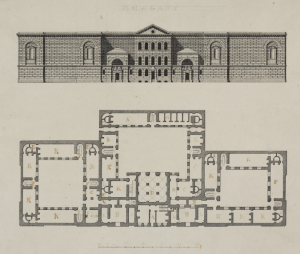
- The Organisation of the Old Bailey
Behind its dignified façade the Old Bailey is a centre of intense activity, with some 1,400 cases heard there each year and some 3,000 people entering the building every day. As well as judges, counsel, jurors, witnesses and defendants, these include the many staff needed to run the courts and the building.
The Old Bailey building is owned and administered by the City of London Corporation, which employs a significant number of staff to operate the facilities. The Keeper of the Central Criminal Court (the Building Manager) is in charge day-to-day with support from Senior Management. City of London Corporation staff handle security, repair and maintenance, cleaning and the provision of catering and other services by contractors. They also deal with administration of the Shrievalty.
Staff of the Courts Service of the Ministry of Justice run the courts, headed by the Court Manager. The work includes the huge and complicated job of assigning cases to courts, ensuring that there are always cases ready and waiting to be heard, with witnesses, defendants and counsel available. The Crown Prosecution Service, Crown Court Witness Services and the London Probation Service each have offices at the Old Bailey. The Prison Service has officers from Belmarsh in charge of some defendants who are in custody, others being in the custody of Home Office custodial contractors.
Modern technology assists the whole operation, from the frequent use of digital tape recordings and video equipment for the giving of evidence in court, to the use of computers and word processors and the development of video links through which the evidence of children and other vulnerable witnesses can be given.
It is a huge task to ensure the smooth running of such a complex organisation. Just under half the operational costs are borne by the Ministry of Justice, all the remainder being met by the City of London Corporation.
The age qualification for entry to the public galleries is fourteen. Opening times are Monday to Friday 09:55am to 12.40pm; and 1.45pm to 3.40pm, the entrances being in Newgate Street for the north of the building and Warwick Slip for the south.
6. The Old Bailey in the Popular Imagination
Changing Perceptions
The Old Bailey holds a firm place in the popular imagination both in its historic incarnations and its present iconic form.
In the eighteenth century the writings of the Newgate Ordinary, the prison Chaplain at Newgate, helped cement the notoriety of the Court and prison in the popular imagination. The Ordinary’s writings were published, in often highly embellished form, as broadsheets and pamphlets of the lives, trials, and executions of criminals which later formed the basis of the Newgate Calendar (subtitled The Malefactors’ Bloody Register), a collection which inspired numerous writers in the following century.
Among those inspired was the legendary Victorian novelist Charles Dickens. Dickens, who worked as a court reporter between 1829 and 1833, was fascinated with London’s criminal underworld and portrayed the Old Bailey and Newgate as dark and fearful places in his literary works; in particular as represented in his novels Oliver Twist, Great Expectations, A Tale of Two Cities, and Barnaby Rudge.
With the demolition of Newgate and the construction of Mountford’s new courthouse, along with the important developments in the justice system throughout the nineteenth century that limited capital sentencing and brought public executions to an end, the popular aura around the Old Bailey as a fearful and notorious place can be said to have transformed in-line with broader changes in attitudes to justice. Perhaps this was a result of its separation from Newgate, as for most of the Court’s history it had existed in-tandem with the heinous gaol.
In 1934 the Lord Chancellor, Lord Sankey, spoke of the “almost revolutionary” change in the attitude of the public towards the punishment of offenders, recalling that at the end of the eighteenth century there were still 200 crimes punishable by death, and children were treated without any distinction from hardened criminals. He said that the judges, advocates and officials of the Central Criminal Court had given it a worldwide reputation as a model criminal court. The Lord Chief Justice, Lord Hewart, declared:
‘It would indeed be hard to imagine a more remarkable contrast than that which is to be observed between the present work and methods and temper of this court and the harshness and the downright brutality of the early part of the last century, with its terrible record of sentences of death, and sentences of transportation, and callousness towards young offenders convicted of trivial offences. Let us beware of attributing the change to mere tendencies, as they are called, or the spirit of the age. The change is largely due to the unceasing efforts of individual lawyers and not least those whose names will always be connected with the history of this court.’
Whilst the Old Bailey does retain a darker interest, since the most serious of crimes are heard in its courtrooms every year, the iconic building and Pomeroy’s statue of Justice that crowns the dome are looked upon more in awe as symbols for the justice system as a whole, in contrast to the gloomier images of Newgate and the historic Old Bailey courthouses that serve to remind us of the advances that have been made in the practice of criminal law and the administration of justice over the centuries.
The Old Bailey on Screen
Mountford’s Old Bailey has loomed large in many courtroom dramas over the years including Alfred Hitchcock’s The Paradine Case (1947) and Billy Wilders’s Witness for the Prosecution (1957). In The Paradine Case the film’s drama centres around the famous court no. 1, for which a set was constructed at Selznick Studios over 85 days at a cost of $80,000! For Hitchcock’s later film Frenzy (1972), however, the trial scene was shot on-location at the Old Bailey’s court no. 1 over the weekend of the 7th—8th August 1971.
The much-loved television series Rumpole of the Bailey (1978-1992) portrays the life and work of elderly and eccentric barrister Horace Rumpole, who defends a variety of clients—often underdogs—over the course of the series as he hears cases at the Old Bailey and frequents the fictional ‘Pomeroy’s Wine Bar.’!
Many other series have used the court as a location to shoot in recent years including Kavanagh QC (1997), In the Red (1998), Law & Order UK (2008-2009), Injustice (2010), The Jury (2011), and the acclaimed Netflix drama The Crown (2017). The forthcoming ITV series Des (2020) starring David Tennant as the notorious serial killer Dennis Nilsen also used the Old Bailey as a location for filming
The Court has also been used as a filming location in several feature films including Closed (2012), Bridget Jones’ Baby (2015), and the DC superhero film Justice League (2016).
The Old Bailey plays a memorable part in the film V for Vendetta (2005). In an authoritarian future the eponymous anti-hero ‘V’ blows up the court building and Pomeroy’s statue of Justice at the beginning of the film, as the court’s purpose and symbolism had become inverted as it was being used as a tool for oppression and injustice. A 1/7th scale model of the Old Bailey that reached 20 metres in height was built by a team of twenty for the scene.
7. Bibliography and Further Readings
BBC On this Day. ‘4th March: Kray twins guiltu of McVitie Murder.’ See: http://news.bbc.co.uk/onthisday/hi/dates/stories/march/4/newsid_2515000/2515103.stm
Beattie, J.M. Garrow, Sir William (1760-1840)’ in ODNB. First published in print on 23rd September 2004. Published online on 30th May 2013.
First published in print on 23rd September 2004. Published online 1st September 2017.
Further Resources:
The Proceedings of the Old Bailey, 1674-1913 – https://www.oldbaileyonline.org/
London Lives 1690-1800: Crime, Poverty, and Social Policy in the Metropolis – https://www.londonlives.org/
9. Index of Images
- London Metropolitan Archives, City of London (Collage: the London Picture Archive, 5588)
- London Metropolitan Archives, City of London (Collage: the London Picture Archive, 318727)
- London Metropolitan Archives, City of London (Collage: the London Picture Archive, 5063)
- London Metropolitan Archives, City of London (Collage: the London Picture Archive, 4922)
- London Metropolitan Archives, City of London (Collage: the London Picture Archive, 176623)
- London Metropolitan Archives, City of London (Collage: the London Picture Archive, 318706)
- London Metropolitan Archives, City of London (Collage: the London Picture Archive, 289190)
- London Metropolitan Archives, City of London (Collage: the London Picture Archive, 36687)
- London Metropolitan Archives, City of London (Collage: the London Picture Archive, 48859)
10. Thanks
His Honour Judge Mark Lucraft QC, the Recorder of London
His Honour Judge Richard Marks QC, the Common Serjeant
Alderman & Sheriff Professor Michael Mainelli (19/21)
Mrs Elisabeth Mainelli
Sheriff Christopher M Hayward CC (19/21)
Mrs Alexandra Hayward
Bob Brown
Elizabeth Scudder
Joanna Burnaby-Atkins
Kathryn Stubbs
Lizzie Vickery @ Collage et. Al (Digital Services at the London Metropolitan Archives or Collage, The London Picture Archive)
Lorraine Brooks
Maris Kraulins
Mick Bagnall
Neil Redcliffe
Nick Lee
Patrick Cowley
Paul Double
Rebecca Collins
Rhiannon Leary
Sean Weir
Wayne Garrigan
Have not as of yet found a source for this. An important point – the etymology for the name ‘Old Bailey’ seems much more contentious. See: https://www.ianvisits.co.uk/blog/2020/04/14/why-is-the-old-bailey-called-the-old-bailey/
